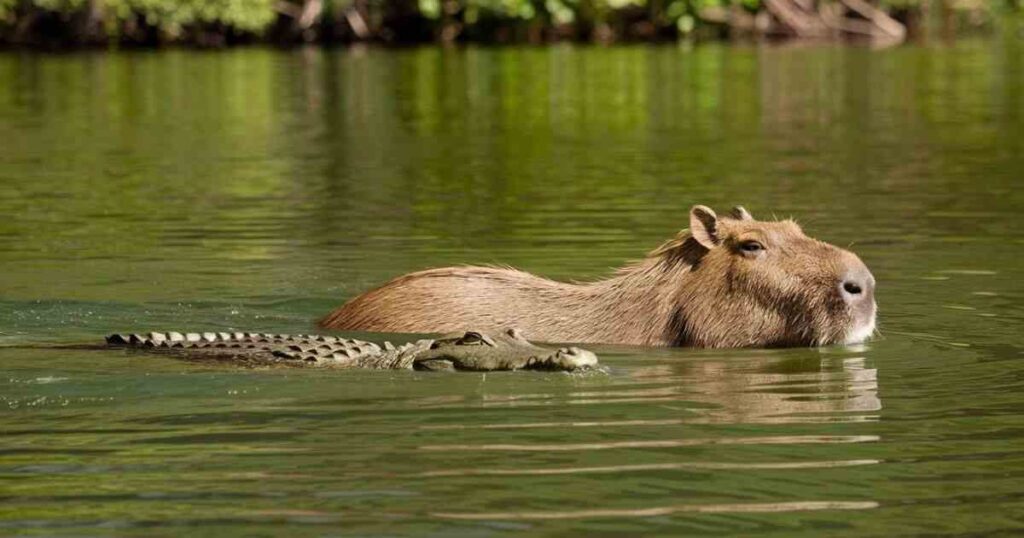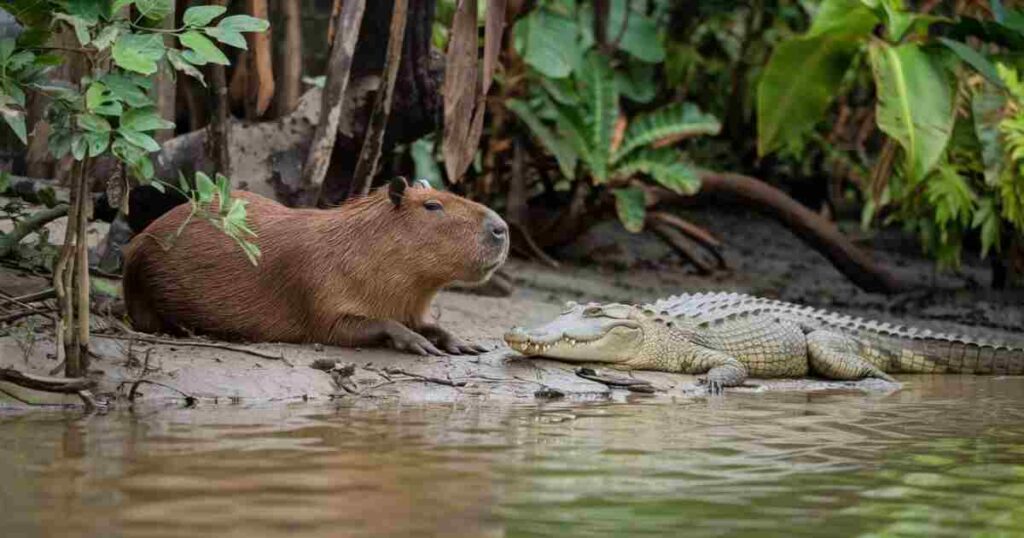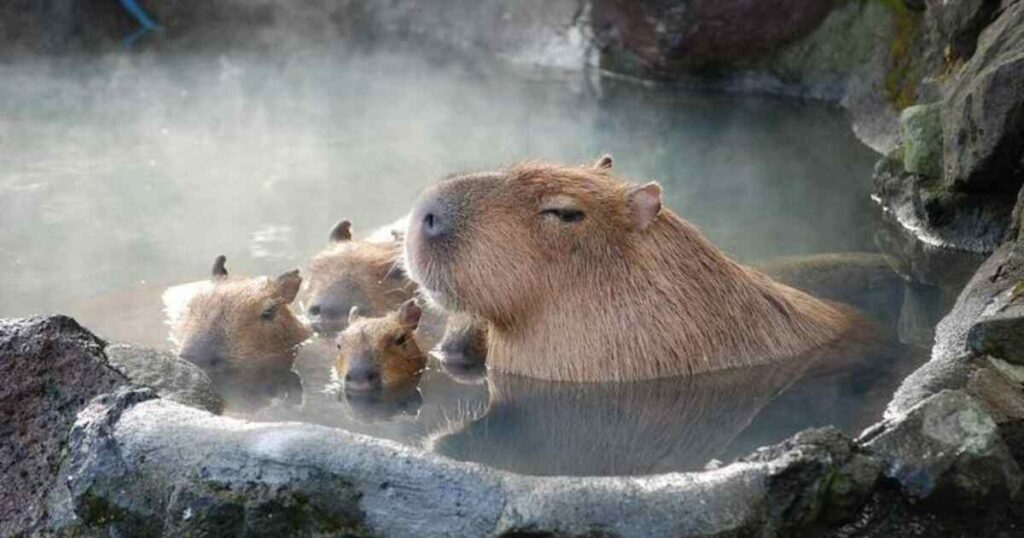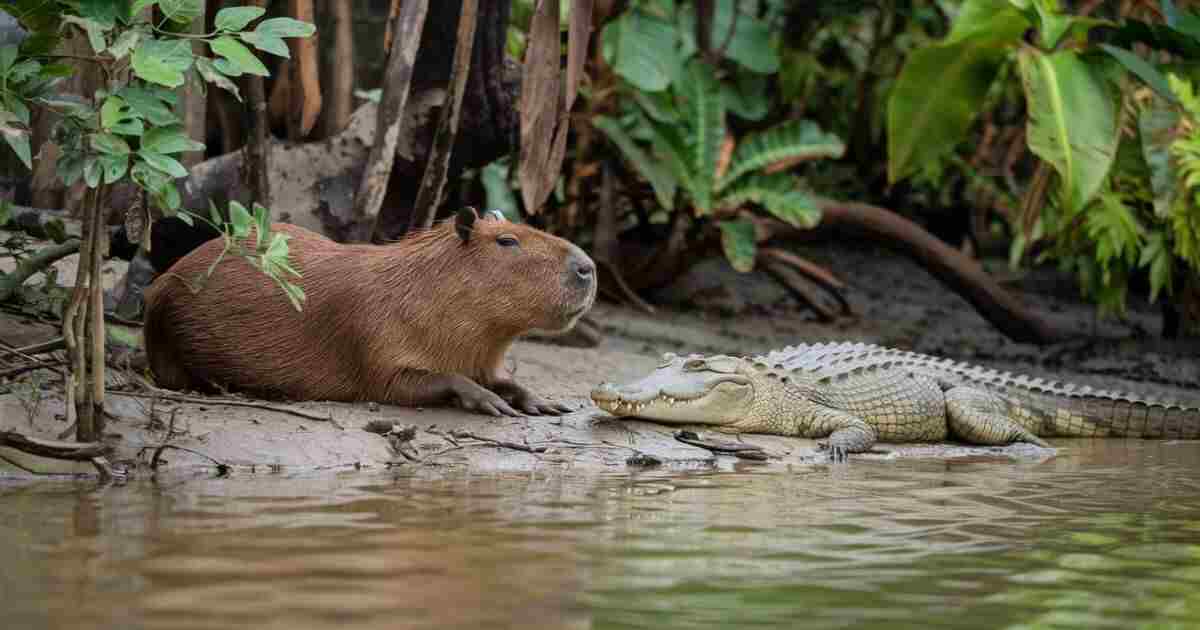The relationship between capybaras and crocodiles is a fascinating example of nature’s complex interactions. These two creatures, despite being vastly different in size and behavior, share a remarkable coexistence in the wild.
In this article, we will discuss deeply the world of capybaras, crocodiles, and their curious relationship, exploring how these giant rodents live peacefully alongside one of nature’s most feared predators.
Capybaras: Sociable Giants of the Animal Kingdom
Capybaras are the world’s largest rodents, known scientifically as Hydrochoerus hydrochaeris. Native to South American wetlands, these animals are highly social and thrive in groups. Their peaceful and non-aggressive nature makes them unique among giant rodents. Capybaras are semi-aquatic and prefer to live near bodies of water, using their strong swimming skills to evade potential predators.
Living in groups helps capybaras protect themselves from threats in their natural habitats. These social animals communicate using various sounds and signals to alert each other of danger. Despite their size, they are prey to several predators, but their group dynamics and the presence of water provide them with an extra layer of security. These ecological factors contribute to their survival in the wild.
Crocodiles: Masters of the Waterways
Crocodiles are powerful predators found in rivers, swamps, and other freshwater environments. These ancient reptiles have been around for millions of years and are often regarded as some of nature’s most fearsome hunters. Their ability to blend into their surroundings and patiently wait for prey showcases their mastery over their ecosystems. Their strong jaws and sharp teeth make them efficient hunters.
Interestingly, crocodiles maintain a balance in their ecosystems by controlling the population of smaller animals. However, their interactions with certain creatures, like capybaras, are rather surprising. These massive reptiles, despite their fearsome reputation, have been observed tolerating the presence of capybaras, adding intrigue to the dynamics of nature’s food chain.
Understanding Capybara Behavior and Habitat
Capybaras are gentle, herbivorous animals that spend most of their time near water, grazing on vegetation. They have evolved to rely on their environment for safety, often seeking shelter in dense wetlands and forests. The presence of water helps them escape from predators, as they can dive and remain submerged for several minutes, making it difficult for predators like jaguars or anacondas to catch them.
Their behaviors around potential threats are also fascinating. Instead of fleeing immediately, capybaras often remain calm and observe their surroundings before taking action. This cautious approach, combined with their excellent swimming abilities, helps them evade danger in their natural habitats.
The Capybara-Crocodile Relationship

The relationship between capybaras and crocodiles has puzzled scientists and wildlife enthusiasts alike. Despite being natural predators, crocodiles often coexist peacefully with capybaras. In some instances, capybaras can be seen lounging on the backs of crocodiles, seemingly without fear of being attacked. This unusual interaction highlights the complexity of animal relationships in the wild.
There are several theories to explain this surprising behavior. Some believe that crocodiles view capybaras as too large or difficult to hunt, especially when easier prey is available. Others suggest that the presence of other animals in the same area may influence the crocodiles’ decision to leave capybaras alone, further illustrating the unpredictable nature of these interactions.
Alligators and Capybaras
While alligators share many similarities with crocodiles, their behavior towards capybaras can differ slightly. Alligators are primarily found in the Americas, and their interactions with capybaras are less documented. However, like crocodiles, alligators are also known for their predatory instincts and their ability to thrive in freshwater environments.
Interestingly, capybaras are not commonly seen near alligators compared to crocodiles. This may be due to the difference in environments where they coexist. Alligators tend to prefer slightly different habitats, which may reduce their chances of encountering capybaras as frequently as crocodiles do.
Predatory Behavior of Crocodiles and Alligators

Both crocodiles and alligators are apex predators, meaning they sit at the top of the food chain in their ecosystems. They rely on stealth and patience to catch their prey, which includes fish, birds, and small mammals. However, despite their aggressive hunting tactics, their relationships with capybaras stand out as an exception.
The predators’ behavior around capybaras shows how adaptable they can be in their environments. Instead of attacking, they sometimes allow capybaras to live peacefully in the same habitat. This is an example of how nature’s interactions are often more complex than they appear.
Capybara Predators
While crocodiles and alligators are often seen as potential threats to capybaras, other animals pose a more significant risk. Jaguars and anacondas are two of the most dangerous predators for capybaras in their native South American habitats. These animals hunt capybaras for food, especially when they stray too far from water sources.
However, capybaras have developed strategies to avoid these predators. Their excellent swimming abilities and group behavior provide them with some protection, but they remain vulnerable to attacks, particularly during the dry season when water sources become scarce.
Human Impact on Capybara Populations
The growing impact of human activity has significantly affected capybara populations. Habitat destruction, primarily due to deforestation and urban expansion, has reduced the availability of wetlands and forests where capybaras live. As a result, capybaras are often forced into smaller areas, making them more vulnerable to predators and human hunters.
In some regions, capybaras are hunted for their meat and skin, further threatening their numbers. Conservation efforts are in place to protect these gentle creatures, but ongoing human activities continue to pose a significant risk to their survival.
The Role of Ecosystems in Capybara Safety

The health of an ecosystem plays a critical role in the safety of capybaras. Wetlands, rivers, and forests provide the ideal shelter for these animals, offering them protection from predators and the opportunity to thrive in their natural environment. The balance between these habitats and the animals living in them is essential for the long-term survival of species like the capybara.
Unfortunately, when these ecosystems are disrupted, the delicate balance is lost, making it harder for capybaras to evade predators and find food. Conservation of these environments is crucial to ensuring the continued existence of this species.
The Intriguing Dynamics of Nature
Nature is full of surprising and unexpected interactions, and the relationship between capybaras and crocodiles is a perfect example. The fact that a giant rodent can coexist peacefully with a dangerous predator challenges our understanding of the natural world. This relationship highlights the complex dynamics within ecosystems and the behaviors that evolve over time.
It also emphasizes the importance of balance in nature, where every species plays a role in maintaining the health of the environment. The capybara-crocodile relationship is a reminder that nature is full of wonder, where even the most unlikely creatures can live together in harmony.
Why Do Crocodiles Not Eat Capybaras?
One of the most frequently asked questions about these two animals is, “Why do crocodiles not eat capybaras?” The answer lies in a combination of factors. Some experts believe that capybaras, being larger and more difficult to catch than other prey, are simply not worth the effort for crocodiles. Additionally, the social behavior of capybaras may deter attacks, as groups can quickly alert each other to danger.
Another theory is that crocodiles might benefit from tolerating capybaras in their habitat. By allowing these animals to coexist, crocodiles can maintain a balanced environment, where smaller prey remains abundant, and competition is minimized.
What’s the Deal with Crocodiles and Capybaras?
The crocodile-capybara relationship is a rare example of how nature can defy expectations. While it would seem that crocodiles should view capybaras as potential prey, the reality is far more complex. This peaceful coexistence could be the result of ecological balance, mutual benefit, or simply an evolutionary quirk.
Whatever the reason, this unusual relationship offers a glimpse into the intricacies of nature’s interactions. It serves as a reminder that the animal kingdom is full of surprises and that even the most fearsome predators are capable of tolerance and peace.
The Future of Capybara-Crocodile Relationships
As we continue to learn more about the natural world, the relationship between capybaras and crocodiles will undoubtedly remain a topic of interest. Understanding these interactions helps us appreciate the delicate balance that exists within ecosystems and the role each species plays in maintaining it.
By studying and protecting these animals and their habitats, we can ensure that future generations will continue to be amazed by the wonders of the natural world.
Frequently Asked Questions
Do capybaras get along with crocodiles?
Yes, capybaras and crocodiles often coexist peacefully, with crocodiles rarely seeing them as prey despite their predatory nature.
What are the predators of the capybara?
Jaguars, anacondas, and humans are the main predators of capybaras.
Why is Capybara so famous?
Their friendly nature, calm behavior, and ability to get along with other animals have made capybaras widely popular online.
Why do capybaras hang out with other animals?
Capybaras are highly social and tend to form bonds with other animals for protection and companionship.
How do capybaras stay safe from predators?
They rely on water for quick escapes and stick together in groups to watch for danger.
Conclusion
In conclusion, capybaras are fascinating creatures known for their social nature and surprising interactions with crocodiles. Despite facing various predators like jaguars and anacondas, they have adapted well to their environments.
Their peaceful demeanor and unique ability to get along with other animals, including potential predators, make them stand out in the animal kingdom. Whether it’s hanging out with crocodiles or forming bonds with other animals, capybaras continue to captivate us with their calm and friendly behavior.
Also Read:

